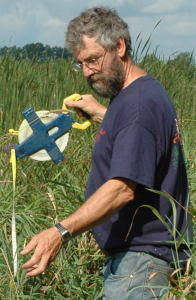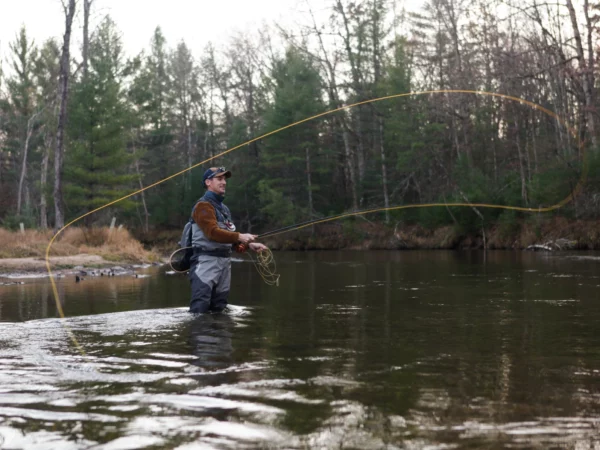
DNR and DEQ divided on controlling invasive Phragmites
A project to hydrologically manage and combat invasive Phragmites in an important wetland bordering Lake St. Clair has two state agencies at odds over stewardship of the land.

Illustration Phragmites australis, courtesy of www.biolib.de
Wetlands are critical to the health of the Great Lakes, and Phragmites is an invasive grass that can aggressively take over a wetland from native species.
Lake St. Clair connects Lake Huron with Lake Erie between Ontario and Michigan.
The Department of Natural Resources, with support from Ducks Unlimited, applied for a permit in 2016 to construct a dike system in the wetland that would assist in Phragmites control, and improve public access for recreation.
In August of 2017, the Department of Environmental Quality denied the permit.
In its denial letter, DEQ said the DNR had “not shown that there is a public need for the proposed dike system” and that “feasible and prudent” alternatives exist to fight Phragmites.
The DNR remains committed to the project and is appealing the decision in an administrative procedure.
Part of the controversy over the project is the installation of dikes which the DEQ says would result in a loss of 38 acres of wetland, and would “isolate an additional 310 acres of wetlands from direct connection” to natural surroundings.
Controlling wetland loss has been a priority for the federal Great Lakes Restoration Initiative (GLRI).
To illustrate the importance of wetlands to the Great Lakes, GLRI has awarded $20 million in grants since 2010 to Central Michigan University for a multi-year project to “protect and restore” coastal wetlands, according to the university website.
FWS Spokesperson Katie Seiger-Meister says GLRI, through the U.S. Fish and Wildlife Service, partially funded the St. John’s Marsh project rejected by the DEQ.
“First you lose the wetland…”
Wetland scientist Dennis Albert is concerned about installing a dike system in a wetland.
“Dike construction comes with high environmental and financial costs” Albert told Great Lakes Now.

Dennis Albert, Assistant Professor (Senior Research), Landscape and Wetland Ecologist, courtesy of Oregon State University
“First, you lose the wetland area under the dike footprint and you lose the wetland area converted to ditch. In addition, the barrier created by the dike prevents the free flow, of oxygenated lake water, and the related nutrients, sediments, and wave energy that are critical to the health of a coastal wetland”, Albert said.
He says securing money to build dikes is relatively easy, but money for long-term maintenance is usually lacking. Albert says, “Then we’re left with one more pond choked with cattails or Phragmites.”
Albert told Great Lakes Now that in his years of work on wetlands, he has not seen one that was diked that controlled Phragmites, but he says he has seen many “diked wetlands in which Phragmites thrives.”
Albert is a Senior Researcher at Oregon State University and has extensive experience with wetlands dating back to 1987. He is the author of Between Land and Lake , a book that is specific to Great Lakes wetlands.
Michigan DNR spokesperson Ed Golder told Great Lakes Now that the permit process on the wetland project “is not finished” and the agency is addressing DEQ’s concerns.
“Now we are working, along with stakeholders, to provide that additional information to the agency to try to meet environmental and regulatory standards while realizing the natural resource benefits of this project,” Golder said.
Golder referred Great Lakes Now to the DEQ for additional information.
Ducks Unlimited said in a 2016 press release announcing the project that the site was “choked with invasive phragmites vegetation” and that the project would “enhance 295 acres of wetlands by improving waterway connections between the marsh and Lake St. Clair.”
Ducks Unlimited spokesperson Chris Sebastian told Great Lake Now that the subject wetland is already a “managed system” but did not address details of the project and said the group’s role is to help DNR control Phragmites.

State Representative Dan Lauwers, courtesy of gophouse.org
The site is in the district of state Representative Dan Lauwers. He tells Great Lakes Now that St. John’s Marsh is a “unique habitat” and that the project would improve the environment by dealing with Phragmites.
“We are disappointed in DEQ’s denial of the DNR permit. It is my understanding that DNR and Ducks Unlimited are working with DEQ to address their concerns,” Lauwers said.
In its denial letter, DEQ said there were “feasible and prudent alternatives” to control Phragmites that would “lessen or eliminate the negative effects of the proposed project.”
The agency said it would be open to review a permit request for an alternate project for the site.
Chris Conn from the DEQ’s Enforcement Unit told Great Lakes Now that the final decision on DNR’s permit rests with MDEQ Director Heidi Grether.




